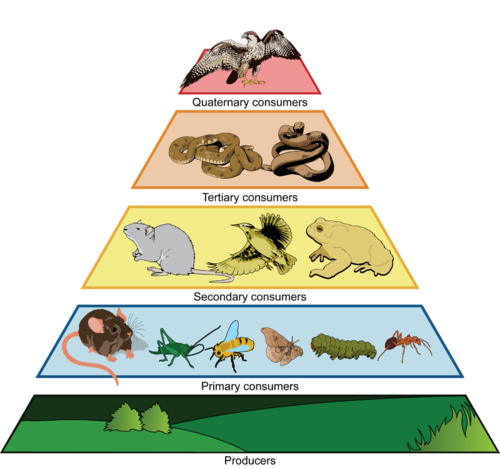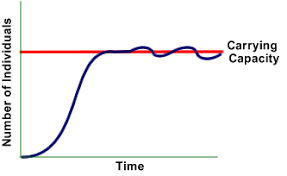Ecology
Relations among organisms and their interactions with their environment is known as Ecology.
Biodiversity: term used to describe the variety of life found on Earth.

Individual = 1 Species
Population = Many of the same speices
Community = Different populations (Biotic Factor = living)
Ecosystem = Various populations along with abiotic factors (non-living) coexisting.
Biome = Many ecosystems (Tundra, Tropical Rain Forest, Desert, etc...)
Biosphere = Many biomes


Biotic vs Abiotic
Abiotic Factors are non-living. Ex: rocks, soil, water, wind, temp.
Biotic Factors are any living. Ex: Plants, Animals, Fungi, Bacteria, and Protists.

Producers = get their energy and produce their own food by use of non-living resources. They are also called autotrophs.
Some organisms use chemicals to make their own food. This is called chemosynthesis.
Consumers = organisms get their energy from living or once living resources such as plants, animals, fungi, bacteria. They are also called heterotrophs.
There are 4 Types of Consumers
Quiz on Intro to Ecology
Law of Conservation of Energy
Energy can not be created or destroyed it can only be transferred from one form to another.
Our Sun is our source of energy. It provides direct and indirect energy to all life on earth.
What would happen to the population of snakes if the cricket population decreased?
What about the owl population?
In Ecology we see interactions among populations mainly through Food Chains and Food Webs
Food Chains show how the organisms are related with each other by the food they eat. The arrow indicates the direction energy travels. They are very simple.

Food Webs are a combinations of Food Chains interacting with one another. They are very complex.
Food Chain Video

Only a 10% of energy is transferred from organism to organism while the rest is lost to heat. TEN PERCENT RULE

Each organism in an environment can be placed in what is known as a Trophic Level, usually represented as a pyramid.
In a Trophic Level Pyramid each level symbolizes a level of nourishment in a food chain.


Biomass Pyramids indicate how much of a certain organism there is in a specific area. Producers occupy most of the land biomass.
Many times certain areas can only sustain so much life. This is known as Carrying Capacity (how much capacity a certain area can sustain).
So when population of consumers increase there are changes in the environment that can lead to deaths in populations until order is restored.


Carrying Capacity
BrainPop Energy Pyramid
Food Fight
Carbon Cycle
Nitrogen Cycle
Water Cycle
Organisms interact with their environment differently. Within a certain ecosystem, organisms tend to occupy their own space called a niche.
A habitat is a place organism lives and a niche is how an organism lives within a habitat.
There are 3 factors that are included in a niche:
1. Food = the type of food it eats, how it competes with others for food, and where in the food web it falls into.
2. Abiotic Conditions = temp. and water a organism can tolerate.
3. Behavior = when the organism is active
Sometimes organisms occupying different niches will compete for food and drive other out of their area.
There are 2 ways organisms interact with each other and their environment.
1. Competition: each compete for resources.
2. Predation: organisms hunting and killing others for nutrients.
Battle at Kruger
Some prey upon others in different niches when hunting. This is called predation, the act of preying upon another organism with the intent to kill and eat it.
Other organisms will interact with each other in a process known as known as symbiosis.
There are 3 forms of
Symbiotic Relationships:
1. Mutualism = (mutual) both organisms benefit from the relationship. Ex: Bees and flowers.
2. Parasitism: (parasite) one organism benefits while the other gets harmed in the process. Some parasites ultimately kill the host. Ex: leech and ticks.
3. Commensalism: one organism benefits while the other is no affected or not bothered. Ex: Sharks and remora.
Succession: is a sequence of changes that recreates a damaged community or creates a new community in an area that was not inhabited before.
There are 2 types of succession:
Primary Succession: This type of succession might begin on cooled lava, after a volcano erupts or it might begin on bare rock that is exposed when a glacier melts. May take longer to develop a habitat.
Secondary Succesion: is the regrowth of a damaged ecosystem in an area that still has healthy soil. Restores the habitat much faster.
Biodiversity: term used to describe the variety of life found on Earth.
Individual = 1 Species
Population = Many of the same speices
Community = Different populations (Biotic Factor = living)
Ecosystem = Various populations along with abiotic factors (non-living) coexisting.
Biome = Many ecosystems (Tundra, Tropical Rain Forest, Desert, etc...)
Biosphere = Many biomes
Biotic vs Abiotic
Abiotic Factors are non-living. Ex: rocks, soil, water, wind, temp.
Biotic Factors are any living. Ex: Plants, Animals, Fungi, Bacteria, and Protists.

Producers = get their energy and produce their own food by use of non-living resources. They are also called autotrophs.
Some organisms use chemicals to make their own food. This is called chemosynthesis.
Consumers = organisms get their energy from living or once living resources such as plants, animals, fungi, bacteria. They are also called heterotrophs.
There are 4 Types of Consumers
- Herbivore = organisms that only eat plants
- Carnivore = organisms that only eat meat
- Omnivore = organisms that eat both plants and meat.
- Decomposers /Detritivores = organisms that eat decaying matter and recycle it back to the environment.
Quiz on Intro to Ecology
Law of Conservation of Energy
Energy can not be created or destroyed it can only be transferred from one form to another.
Our Sun is our source of energy. It provides direct and indirect energy to all life on earth.
What would happen to the population of snakes if the cricket population decreased?
What about the owl population?
In Ecology we see interactions among populations mainly through Food Chains and Food Webs
Food Chains show how the organisms are related with each other by the food they eat. The arrow indicates the direction energy travels. They are very simple.
Food Webs are a combinations of Food Chains interacting with one another. They are very complex.
Food Chain Video
Only a 10% of energy is transferred from organism to organism while the rest is lost to heat. TEN PERCENT RULE

Each organism in an environment can be placed in what is known as a Trophic Level, usually represented as a pyramid.
In a Trophic Level Pyramid each level symbolizes a level of nourishment in a food chain.

Biomass Pyramids indicate how much of a certain organism there is in a specific area. Producers occupy most of the land biomass.
Many times certain areas can only sustain so much life. This is known as Carrying Capacity (how much capacity a certain area can sustain).
So when population of consumers increase there are changes in the environment that can lead to deaths in populations until order is restored.
Carrying Capacity
BrainPop Energy Pyramid
Food Fight
Carbon Cycle
Nitrogen Cycle
Water Cycle
Organisms interact with their environment differently. Within a certain ecosystem, organisms tend to occupy their own space called a niche.
A habitat is a place organism lives and a niche is how an organism lives within a habitat.
There are 3 factors that are included in a niche:
1. Food = the type of food it eats, how it competes with others for food, and where in the food web it falls into.
2. Abiotic Conditions = temp. and water a organism can tolerate.
3. Behavior = when the organism is active
Sometimes organisms occupying different niches will compete for food and drive other out of their area.
There are 2 ways organisms interact with each other and their environment.
1. Competition: each compete for resources.
2. Predation: organisms hunting and killing others for nutrients.
Battle at Kruger
Some prey upon others in different niches when hunting. This is called predation, the act of preying upon another organism with the intent to kill and eat it.
Other organisms will interact with each other in a process known as known as symbiosis.
There are 3 forms of
Symbiotic Relationships:
1. Mutualism = (mutual) both organisms benefit from the relationship. Ex: Bees and flowers.
2. Parasitism: (parasite) one organism benefits while the other gets harmed in the process. Some parasites ultimately kill the host. Ex: leech and ticks.
3. Commensalism: one organism benefits while the other is no affected or not bothered. Ex: Sharks and remora.
Review Video
Succession: is a sequence of changes that recreates a damaged community or creates a new community in an area that was not inhabited before.
There are 2 types of succession:
Primary Succession: This type of succession might begin on cooled lava, after a volcano erupts or it might begin on bare rock that is exposed when a glacier melts. May take longer to develop a habitat.
Secondary Succesion: is the regrowth of a damaged ecosystem in an area that still has healthy soil. Restores the habitat much faster.
















